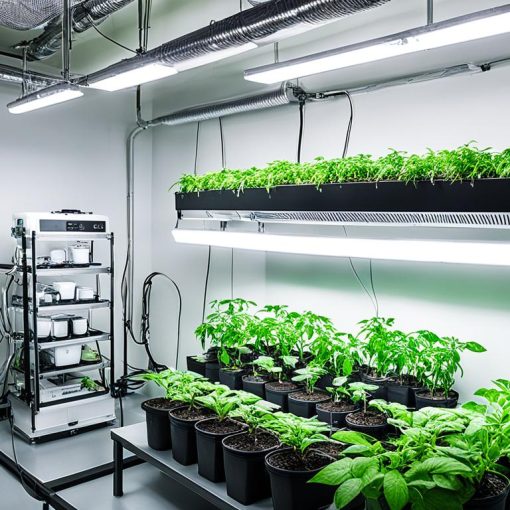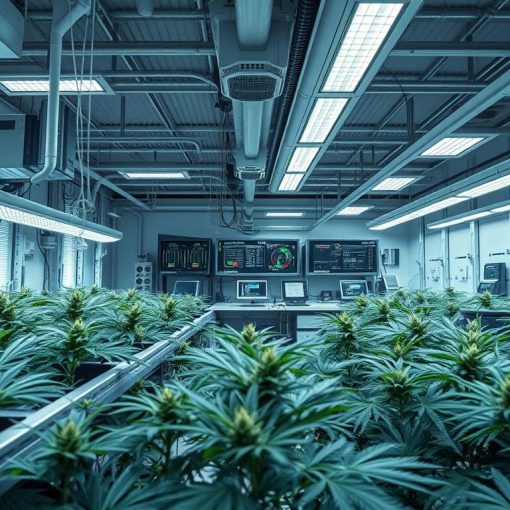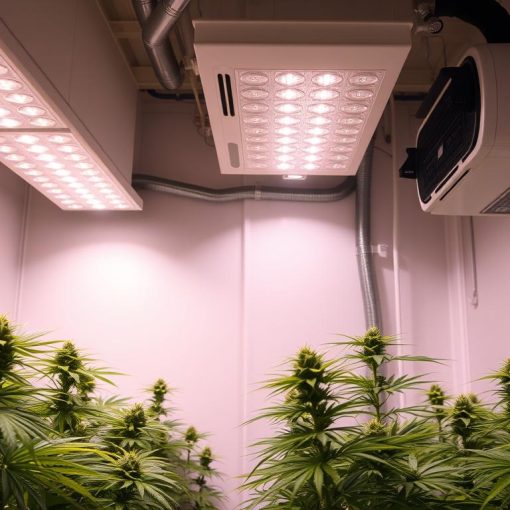Growing high-quality cannabis needs careful control of the environment. The cannabis plant reacts to many environmental factors. Keeping the climate just right is key for strong plants, lots of yield, and tasty buds. This guide covers the basics of controlling the climate for cannabis, helping growers make their indoor spaces better.
By controlling temperature, humidity, air flow, and more, growers can boost their cannabis yields and quality. This article will look into the science of creating the best climate for cannabis. We’ll talk about managing temperature and humidity, air flow, lights, and CO2. We’ll also cover designing grow rooms, using monitoring systems, saving energy, and fixing common issues to keep cannabis growing well.
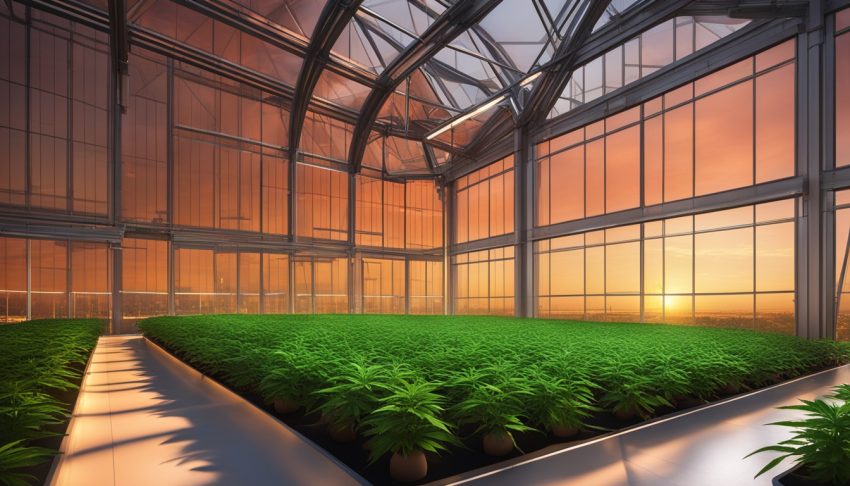
Key Takeaways
- Getting the climate right is key for top-notch cannabis yields and strong, tasty buds.
- Knowing about temperature, humidity, air flow, and lighting is vital for a great growing space.
- Using smart climate control methods, like managing temperature and humidity, and improving air flow and CO2, boosts plant health and productivity.
- Good grow room design, insulation, and advanced systems make growing more efficient and green.
- Fixing common climate issues and preventing them keeps the grow space healthy.
What is Cannabis Climate Control?
Cannabis climate control means managing the environment in a grow room or indoor facility. It’s key for the plants to grow well and stay healthy. They need the right temperature, humidity, airflow, and lighting.
Understanding the Importance of Controlled Environments
Cannabis plants are very sensitive to their environment. Small changes can affect their growth, yield, and quality. With good cannabis climate control, growers can give their plants the best conditions. This helps them grow to their full potential.
Key Factors in Cannabis Climate Control
- Temperature: The right temperature is vital for healthy growth and avoiding damage from heat or cold.
- Humidity: The right humidity levels help with the plant’s water loss and prevent mold or mildew.
- Airflow: Good air circulation is needed to spread out gases like carbon dioxide and oxygen in the grow space.
- Lighting: The right amount and type of light is key for photosynthesis and plant shape.
By controlling these factors, growers can make the best environment for their plants. This leads to better growth, yield, and quality. Cannabis HVAC systems are key in keeping these conditions right.
Temperature and Humidity Management
Getting the temperature and humidity right is key for cannabis plants to grow well. It’s all about finding the right balance. With the right cannabis HVAC and climate control, growers can make an ideal space for their plants.
Ideal Temperature Ranges
The best temperature for growing cannabis is between 68°F (20°C) and 85°F (29°C) during the day. At night, it should be between 55°F (13°C) and 70°F (21°C). If the temperature changes too much, it can stress the plants and hurt their health and yield.
Humidity Management
Humidity should be kept between 40% to 70% for the best cannabis growth. Too much humidity can cause mold and mildew. Too little humidity can dry out the plants and make them vulnerable to pests and diseases.
- Use dehumidifiers or humidifiers to keep humidity in check
- Check and adjust humidity often to stay in the ideal range
- Make sure there’s good air flow to avoid damp, humid spots
By controlling temperature and humidity, cannabis HVAC and climate control systems are key to a great growing space for cannabis. Getting these factors right is vital for high yields and healthy, quality plants.
Ventilation and Air Circulation
Proper ventilation and air circulation are key for a healthy cannabis grow room. This part talks about how to design and use exhaust systems, fresh air intake, and air circulation. These steps help keep the air fresh, stop mold and mildew, and prevent nutrient problems.
Exhaust Systems and Fresh Air Intake
A good cannabis hvac design needs a strong exhaust system. It takes out old, humid air from the room. This keeps the temperature and humidity right, stopping harmful contaminants.
It’s also vital to have a good fresh air intake. This brings in clean, oxygen-rich air for the plants to grow well.
Air Circulation Strategies
For a strong grow room hvac, you need a good air circulation plan. This might mean using fans, ducts, and air handlers to move air around the space evenly. Good air flow spreads nutrients, CO2, and other important stuff. It also helps plants grow evenly and stops hot or cold spots.
| Ventilation Component | Purpose | Considerations |
|---|---|---|
| Exhaust System | Removes stale, humid air | Ensure sufficient capacity, proper placement, and effective control mechanisms |
| Fresh Air Intake | Supplies clean, oxygenated air | Monitor air quality, filter as needed, and integrate with exhaust system |
| Air Circulation Fans | Distribute air throughout the grow room | Optimal placement, speed, and airflow patterns to promote even distribution |
With a strong ventilation and air circulation system, growers can make the best environment for cannabis. This leads to healthier plants, more production, and stops common problems.
Lighting and Heat Management
In the world of cannabis cultivation, using the right lighting and climate control is key. Cannabis plants need specific lighting, and grow lights can create a lot of heat. It’s important to balance these factors for healthy plants.
Choosing the right lighting is crucial for managing the climate. HID lights like HPS or MH bulbs can get very hot. LED grow lights are a better choice because they’re more energy-efficient and don’t get as hot.
Integrating Lighting and Climate Control
For successful cannabis climate control, you need to link lighting with other climate tools like temperature and humidity control, ventilation, and air flow. Managing the heat from grow lights helps keep the temperature right for plants. This prevents heat stress and ensures plants grow well.
- Place lights to improve airflow and cool down the area
- Use cooling systems like air conditioning or evaporative cooling to reduce heat
- Add exhaust fans and ducts to remove hot air from the space
By balancing lighting, heat management, and climate control, growers can create a great environment for their plants. This lets plants grow to their best potential.
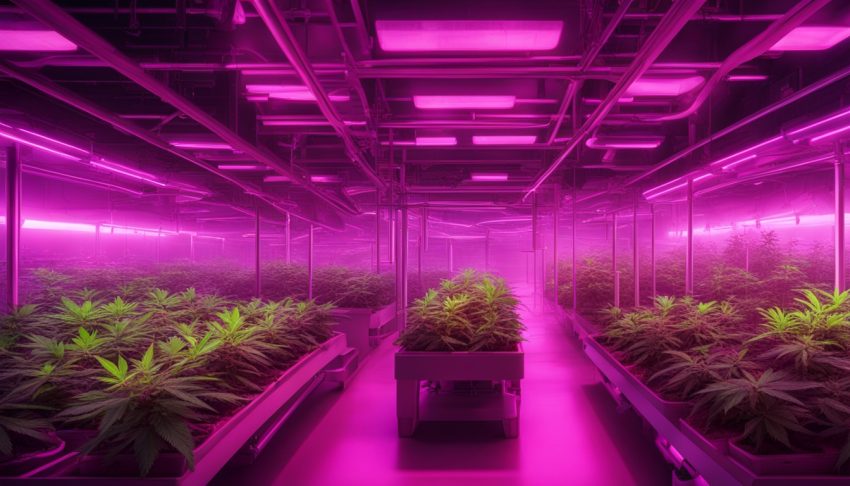
Proper lighting and managing heat are key to a good cannabis climate control plan. By combining these, growers can get a healthy, high-quality crop in the best conditions.
Carbon Dioxide Enrichment
In the world of cannabis cultivation, managing the grow room climate is key for the best plant growth and productivity. Adding extra carbon dioxide (CO2) to the grow space is a big part of this. This method brings many benefits that can boost yields and improve plant health.
Benefits of CO2 Supplementation
CO2 enrichment helps cannabis plants by making photosynthesis more efficient. With more CO2, plants grow bigger and produce more of the cannabis compounds we want. It also makes plants grow faster, improves their structure, and helps them handle stress better.
A study in the Journal of the American Society for Horticultural Science found that cannabis plants with more CO2 grew 21% heavier than those without.
“Optimal CO2 levels can boost cannabis yields by up to 20% or more, making it a crucial component of any advanced climate control strategy.”
Adding CO2 to the climate control system needs careful planning and watching. Growers must keep CO2 levels between 800 to 1,500 parts per million (ppm). This ensures the best benefits without causing plant stress or wasting energy.
Grow Room Design Considerations
The design of the grow room is key for cannabis cultivation. It ensures the climate is just right for plants. This means using insulation and vapor barriers well.
Insulation and Vapor Barriers
Insulation is vital in hvac design for cannabis. It keeps the temperature and humidity steady. This cuts down on the work for climate control systems. Vapor barriers stop moisture from getting in, keeping the grow room dry and perfect for plants.
- Insulation helps regulate temperature and humidity
- Vapor barriers prevent moisture intrusion
- Proper insulation and vapor barriers reduce energy costs
- Optimizing the grow room design can improve overall climate control
Using good insulation and vapor barriers makes a controlled space for cannabis plants. This leads to better yields, less energy use, and a more efficient cannabis hvac design.
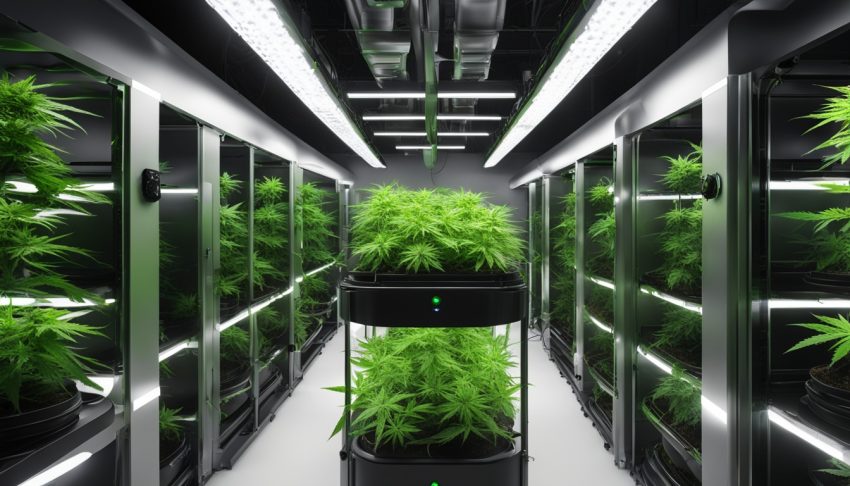
| Insulation Type | R-Value | Pros | Cons |
|---|---|---|---|
| Fiberglass | R-13 to R-30 | Cost-effective Readily available | Can be irritating to install May settle over time |
| Spray Foam | R-6 to R-7 per inch | High R-value Effective air sealing | More expensive Requires specialized equipment |
| Rigid Foam | R-4 to R-7 per inch | Versatile installation Moisture resistant | Higher cost Potential for gaps and cracks |
By thinking about insulation and vapor barriers, cannabis growers can make a space that’s perfect for cannabis hvac design. This helps plants grow well and boosts yields.
cannabis climate control
In the world of cannabis cultivation, keeping the climate just right is key for strong plant growth and steady yields. Cannabis climate control uses different strategies and tech to make the best environment for plants.
Managing temperature and humidity is a big part of cannabis HVAC. Growers must watch and adjust these to help plants grow well. It’s also vital to have good air flow. This brings in fresh air, takes out old air, and keeps the temperature and humidity right.
- Exhaust systems and fresh air intake keep the air moving and clean.
- Fans and ducts help spread temperature and humidity evenly in the grow space.
Lighting and heat control are key in cannabis climate control too. Growers need to balance light for photosynthesis with heat control. Using energy-saving LED lights and cooling systems helps keep the temperature perfect.
Adding carbon dioxide (CO2) can also boost plant growth and productivity. Knowing the best CO2 levels and how to add it helps make the climate better for cannabis plants.
Cannabis climate control is complex and needs a good understanding of the plant and the right tech and methods. By getting good at these strategies, growers can make the best environment for their cannabis plants. This leads to great yields.
Monitoring and Control Systems
In the world of cannabis cultivation, keeping a stable grow room climate is key. Advanced monitoring and control systems help growers manage their grow environment easily. They make sure everything is just right for the plants.
Automated Climate Control Technologies
Automated climate control systems have changed the game for cannabis growers. They offer unmatched precision and efficiency. These systems use sensors to keep an eye on temperature, humidity, lighting, and cannabis climate control factors. They adjust the environment automatically to keep it perfect for plants.
- Temperature and Humidity Sensors: These sensors watch the grow room’s temperature and humidity levels. They make sure these are always right.
- Cannabis HVAC Systems: These systems work with the control system to control airflow, temperature, and humidity. They keep the environment just right.
- Lighting Controllers: These controllers work with the system to adjust lighting. They make sure the light is right for plant growth.
- Environmental Monitoring Dashboards: These dashboards give growers a clear view of the grow room’s conditions. They help growers make smart decisions and fix problems fast.
By using these advanced technologies, cannabis growers can control their grow rooms better than ever. This leads to healthier plants and more yields.
“Automated climate control systems have revolutionized the cannabis industry, providing growers with unparalleled precision and efficiency.”
Energy Efficiency and Sustainability
The cannabis industry is growing fast, making it key for growers to focus on using energy wisely and being sustainable. Growing cannabis indoors needs a lot of energy for the right temperature, humidity, and light. But, using cannabis hvac systems that save energy can cut down on costs and harm to the environment.
Using cannabis hvac systems that use less energy is important. These systems have features like variable-speed compressors and precise control over temperature and humidity. This lets growers keep the best growing conditions while using less energy.
Adding renewable energy like solar panels or wind turbines also helps make growing cannabis better for the planet. This way, growers use less electricity from the grid, which lowers their carbon footprint and costs over time.
Growers can also be eco-friendly by using grow room hvac systems that use waste heat, saving water, and managing waste in a green way. These steps make sure the cannabis industry grows without harming the environment too much.
| Energy-Efficient Cannabis Climate Control Strategies | Benefits |
|---|---|
| High-efficiency HVAC systems | Reduced energy consumption, improved temperature and humidity control |
| Renewable energy sources (solar, wind) | Lower carbon footprint, reduced grid-supplied electricity reliance |
| Waste heat recovery systems | Improved energy efficiency, reduced energy costs |
| Water conservation strategies | Reduced water usage, environmental stewardship |
| Sustainable waste management | Proper disposal of grow room waste, environmental responsibility |
By focusing on using energy wisely and being sustainable, growers can lessen their environmental impact. This also helps them stay competitive and profitable in the changing cannabis industry.
Troubleshooting Common Climate Control Issues
Keeping the climate right is key for growing cannabis well. Even with careful planning, growers might face problems. This guide helps with common climate control issues to keep the grow operation healthy and productive.
Temperature Fluctuations
Big temperature changes can stress plants and lower yields. To fix this, growers should:
- Check temperature often in the grow area
- Make sure HVAC systems work well and efficiently
- Change thermostat settings to keep the right temperature
- Think about adding insulation or extra heating/cooling if needed
Humidity Imbalances
Keeping the right humidity is vital for cannabis plants. Growers should:
- Use hygrometers to check humidity levels
- Change dehumidifiers or humidifiers to keep humidity in check
- Make sure air moves well to avoid humid spots
- Think about a dedicated climate control system if humidity problems don’t go away
Ventilation Challenges
Good ventilation brings in fresh air, takes out stale air, and keeps temperature and humidity right. If ventilation problems happen, growers should:
- Make sure all fans and ducts work right
- Keep the air exchange rate at a good level
- Adjust vent positions or angles if needed
- Think about a better ventilation system if it’s necessary
By solving these common cannabis climate control problems, growers can keep their operation thriving. This helps plants stay healthy and boosts their yield.
Conclusion
Mastering climate control is key in cannabis cultivation for success. By knowing what makes the best growing conditions, growers can make their crops reach their full potential. This leads to better products for the market.
This guide covered the main parts of cannabis climate control. We talked about managing temperature, humidity, ventilation, lighting, and carbon dioxide. With the right strategies and tech, growers can make a perfect environment for their cannabis plants to thrive.
The cannabis industry is always changing. Staying on top of climate control will help growers stay competitive. By keeping an eye on their grow rooms and making changes as needed, growers can improve their yields, strength, and product quality. This ensures their success in a fast-growing market.
FAQ
What is cannabis climate control?
Cannabis climate control means managing the environment in a grow room or indoor facility. It involves controlling temperature, humidity, airflow, and other factors. This creates the best growing conditions for cannabis plants.
Why is maintaining a controlled environment important for cannabis cultivation?
Keeping the grow room climate precise is key for cannabis plants to grow well. It helps with yield, potency, and quality. By controlling temperature, humidity, and ventilation, growers get better results.
What are the key factors in cannabis climate control?
Important factors include temperature, humidity, airflow, lighting, and CO2 levels. Growers must watch and manage these to create a great environment for their plants.
How can growers maintain optimal temperature and humidity levels in the grow room?
For the right temperature and humidity, growers use HVAC systems, dehumidifiers, and climate control tech. They also use insulation and vapor barriers.
Why is proper ventilation and air circulation important in a grow room?
Good ventilation stops mold, mildew, and nutrient issues. Growers should use exhaust systems and air intake. This keeps the environment healthy and oxygen-rich.
How can growers manage the heat generated by grow lights?
Grow lights can make the room too hot. Growers use HVAC systems and heat exchangers to manage the heat. This keeps the growing conditions perfect.
What are the benefits of CO2 enrichment in a cannabis grow room?
CO2 enrichment boosts photosynthesis and yields. By adding CO2 to the grow room, growers can improve the growing environment.
How can grow room design considerations impact climate control?
The grow room’s design, like insulation and vapor barriers, affects climate control. Growers should think about these to keep the environment ideal for plants.
What types of monitoring and control systems can be used for cannabis climate control?
Automated systems and sensors are key for a stable grow room climate. They let growers monitor and adjust conditions in real-time.
How can growers improve the energy efficiency and sustainability of their cannabis climate control systems?
Growers should focus on energy efficiency and sustainability. Using energy-efficient HVACs and renewable energy can help. This reduces the environmental impact of growing cannabis indoors.
How can growers troubleshoot common climate control issues in their grow rooms?
Growers might face issues like temperature and humidity problems. This section helps with troubleshooting. It ensures the grow operation stays healthy and productive.


